Lithuanian talonas
The talonas was a temporary currency issued in Lithuania between 1991 and 1993. It replaced the Soviet ruble at par and was replaced by the litas at a rate of 100 talonas = 1 litas. The talonas was only issued as paper money.

The first talonas reform
| Year | Inflation rate (%) | |
|---|---|---|
| In Lithuania | In Russia | |
| 1991 | 225 | N/A |
| 1992 | 1100 | 2508.8 |
| 1993 | 409 | 849.9 |
| 1994 | 45.1 | 215.1 |
| 1995 | 35.7 | 175.0 |
| 1996 | 13.1 | 21.8 |
| 1997 | 8.4 | 11.0 |
| 1998 | 2.4 | 84.4 |
| 1999 | 1.5 | 36.5 |
| Sources , , | ||

On 5 August 1991, as a response to public complaints about inflation, the Lithuanian government introduced the talonas, paid out as a supplement to the salaries in rubles.[1] It was a quick and unforeseen reform pushed by the Prime Minister of Lithuania Gediminas Vagnorius. At first, it was very similar to ration coupons: every person received 20% of his/her salary in talonas up to a maximum of 200 talonas. In order to buy goods other than food, a person had to pay the price in rubles and again in talonas (for example, if a pair of shoes cost 50 rubles, a person had to pay 50 rubles and 50 talonas to buy them).
This system was widely criticized. First of all, in no way did it address the reasons why there were shortages of goods, i.e., it did not promote supply; it just limited demand. Also, the demand for expensive goods (like home appliances) dropped sharply because people needed a lot of time to accumulate the necessary amount of talonas to buy them. It caused bottlenecks in the supply chain and further damaged already troubled production. In addition, the scheme could not prevent hyperinflation of the ruble because the talonas was not an independent currency; it was a supplementary currency with a fixed exchange rate to the ruble. The system tried to encourage Lithuanians to save 80% of their salaries. But people accumulated their rubles and had nowhere to spend them. It led to the inflation of goods that did not require the talonas (like food or goods on the black market).
 0,10 talonas
0,10 talonas 0,20 talonas
0,20 talonas 0,50 talonas
0,50 talonas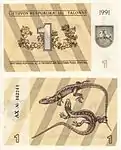 1 talonas
1 talonas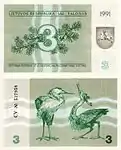 3 talonas
3 talonas 5 talonas
5 talonas 10 talonas
10 talonas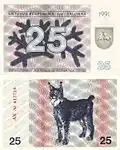 25 talonas
25 talonas 50 talonas
50 talonas 100 talonas
100 talonas
The second talonas reform
In the summer of 1992, everybody anticipated that the talonas would shortly be replaced by a permanent currency, the litas. Lithuania was desperately lacking cash (some workers were paid in goods rather than in cash) as Russia tightened its monetary policy. In addition, litas coins and banknotes had already been produced and shipped to Lithuania from abroad. However, on 1 May 1992, it was decided to reintroduce the talonas as an independent, temporary currency to circulate alongside the ruble in hopes to deal with inflation. A dual currency system was created. On 1 October 1992, the ruble was completely abandoned and replaced by the talonas. Lithuania was the last of the Baltic states to abandon the ruble. The self-imposed deadlines to introduce the litas were continuously postponed without clear explanations.
Nicknamed "Vagnorkės" or "Vagnoriukai" after Gediminas Vagnorius or "zoo tickets" after various animals native to Lithuania featured on the notes, the talonas did not gain public trust or respect. The banknotes were small and printed on low quality paper. People were reluctant to use them. Nevertheless, the talonas served its purpose: inflation at the time was greater in Russia than in Lithuania. Inflation in 1992 rose steadily due to an energy price spike after Russia increased oil and gasoline prices to world levels and demanded to be paid in hard currency.
 1 talonas
1 talonas 10 talonas
10 talonas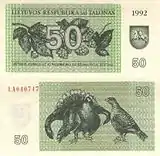 50 talonas
50 talonas 100 talonas
100 talonas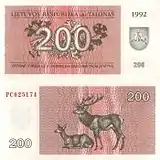 200 talonas
200 talonas 500 talonas
500 talonas
On June 25, 1993, the litas was introduced at the rate of 1 litas = 100 talonas. Worthless talonas were recycled into toilet paper in the Grigiškės paper factory.[2]
Banknotes
| Wikimedia Commons has media related to Lithuanian talonas. |
In 1991, notes were issued in denominations of 0.10, 0.20, 0.50, 1, 3, 5, 10, 25, 50 and 100 talonas. In 1992, notes were issued for 1, 10, 50, 100, 200 and 500 talonas, followed by new designs of the 200 and 500 talonas notes in 1993.
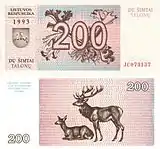 200 talonas (1993)
200 talonas (1993) 500 talonas (1993)
500 talonas (1993)
References
- Inline
- Linzmayer, Owen. The Banknote Book: Lithuania. www.BanknoteNews.com. 2013. San Francisco, CA. http://www.banknotebook.com
- Gvozdaitė, Laura (2008-10-07). "Sudilusių pinigų reinkarnacija". Lietuvos rytas (in Lithuanian). Archived from the original on 2010-11-30.
- General
- Kurt Schuler; George Selgin & Joseph Sinkey, Jr. (1991-10-28). "Replacing the Ruble in Lithuania: Real Change versus Pseudoreform". Cato Policy Analysis (163). Archived from the original on 2006-12-11. Retrieved 2007-01-03.
| Preceded by: Soviet ruble Reason: introduction of temporary currency Ratio: 1 talonas = 1 or 10 rubles |
Currency of Lithuania 1 May 1992 – 26 June 1993 |
Succeeded by: Lithuanian litas Reason: introduction of permanent currency Ratio: 1 litas = 100 talonas |